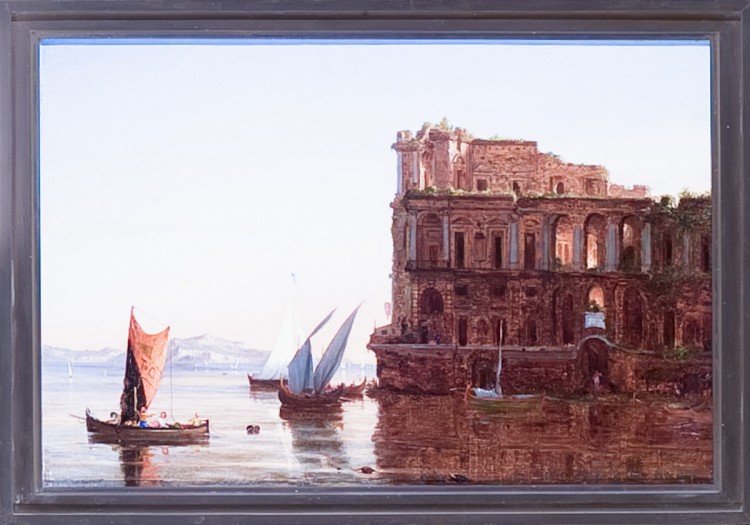
Palazzo della Regina Giovanna, Naples
c.1832
Painting- Oil on canvas; Frame- Cast compo ornament with decorative design on a gesso background
Thomas Cole
JJ.1958.386
This painting by Thomas Cole depicts the Palazzo della Regina Giovanna in the bay of Naples. The palace was built in the 14th century but was remodeled in both the 17th and 18th centuries. It was built for Joanna I of Naples, a queen from 1328-1382 and a scandalous figure in medieval Italian history; Joanna was accused of killing her first husband to ensure her continued rule, having multiple affairs and was assassinated in 1382.
Painted around 1832, Cole depicts the palace in such a way that makes it look like the ruins of a once-thriving civilization; this depiction fit with a popular 18th and early 19th century philosophy which refers to man’s struggle against the overwhelming power of nature. By showing the palace in ruins and returning to nature, it connotes the futility of man’s efforts and how nature will reclaim what is manmade eventually. The sailboats in the harbor also indicate man’s encroachment upon nature, and the closest one has Cole’s initial painted on their sail.
Thomas Cole was born on February 1st, 1801 in England. His family first immigrated to Philadelphia but eventually settled in Ohio. Around 1826, Cole moved to Catskill, New York located on the western bank of the Hudson River. From there, he would often travel around the area and make pencil studies of the landscape. He spent two tours abroad in Italy, from 1829-32 and from 1841-42; later he would become one of the founders of the Hudson River School.
The name “Hudson River School” was applied retrospectively and referred to American landscape painters who worked between about 1825 and 1870. It was more about the artists’ similar style or intent instead of their geographic location; although, many of the older members of the group drew inspiration from the picturesque Catskill region, north of New York City. It was the first native school of painting in the United States; it showcased a pride and celebration of the natural beauty of America’s landscape and its artists’ desire to become independent of European schools of painting.
Thomas Cole’s talent was first recognized by John Trumbull who saw Cole’s landscapes of the Hudson River in 1825. He was the one who brought Cole to the attention of patrons and other artists in the NYC cultural community, possibly including the Jay family.
Cole aspired to a “higher style of landscape” which blended the genre with characteristics of history painting, including the typical heroic, moral and religious themes that can be seen in some of his works.
Cole’s success in NYC earned him enough money to fund a Grand Tour in Europe where he stayed in Italy between 1831-32 and started this painting. The painting was commissioned by Hickson Woolman Field, the father of Eleanor Kingsland Field Jay, who married John Jay II.
You may view the Object of the Day Archives HERE
